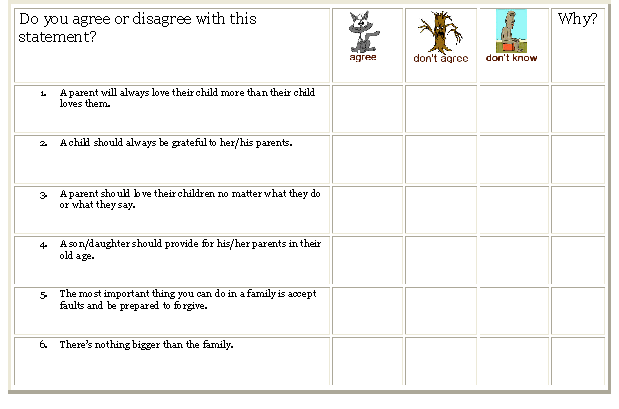|
Parents and Children
PERIOD 1
WARM-UP ACTIVITIES
1) THE INQUIRY FRAME: PARENTS AND CHILDREN – PART 1 (15 min.)
AIM: The inquiry frame intends to introduce one of the play’s key themes – relationships between parents and children - and make a connection between the concerns of the play and the lives of the students. Hence any one of the following might work well:
1) What characterizes a “good ” parent/child relationship?
2) What does it mean to be a “good” son/daughter/parent?
3) We hear a lot about dysfunctional families. What constitutes a functional family?
PROCEDURE: This activity may be run as a journal writing followed by small group/full group discussion or simply the latter. The teacher finds out how the students characterize their own relationships with their parents . What are the positive and negative aspects of their relationships? Hopefully the class will end up discussing the fine line parents have to tread between being sufficiently protective and being over-protective of their teenage sons and daughters. There is a range of experience, and the students with “older” parents might identify the gap in their ages as perhaps being significant in their parents “failure to understand them”.
2) THE OPINIONAIRE: PARENTS AND CHILDREN – PART 2 (15 min.)
AIM: To give students the opportunity to think about their relationships with their parents and express their opinions about them. PROCEDURE: The teacher hands out this chart and asks his/her class to fill it in by ticking the agree/disagree/don’t know columns and giving reasons for their answers. Students work individually, then they share their responses in small groups. After a few minutes, the discussion is opened up to the whole class.

3) THE ROLE PLAY: THE INHERITANCE (25 min.)
The last ice-breaker is a role play where the plot of the opening scene is set in a present day context. AIM: To provide a modern setting of the story and make the original version more accessible to a young audience. PROCEDURE: the teacher gets his/her class to work in small groups (three/four). Students are asked to outline the profile of “the best successor” in a boss’ business and appoint an actor within their groups who will play the role they have defined. Once they have come to an agreement and defined the best successor, the appointed actors (one per group) play their roles, while the others vote the best (most convincing) performance. Before doing the activity, it might be useful to pre-teach the word “CEO” : “Chief Executive Officer. Person with the highest rank in a business organization”. After the role-play, students might enjoy - with some help - the illustrated joke below. The teacher may show it by using the over-head projector, or may decide to print it out and give copies to his/her students. Difficult words such as “thwarted” and “yearning” might require explanation and/or clarification. The following would do:
thwarted: “distorted”
yearning: “strong desire”
Read, discuss, then play the “best” role.
A corporate boss must hand over the reins of his company to his children.
1. Who will be the next CEO?
2. On what basis will he select?
3. How will he make it fair?

 2/11
2/11

|